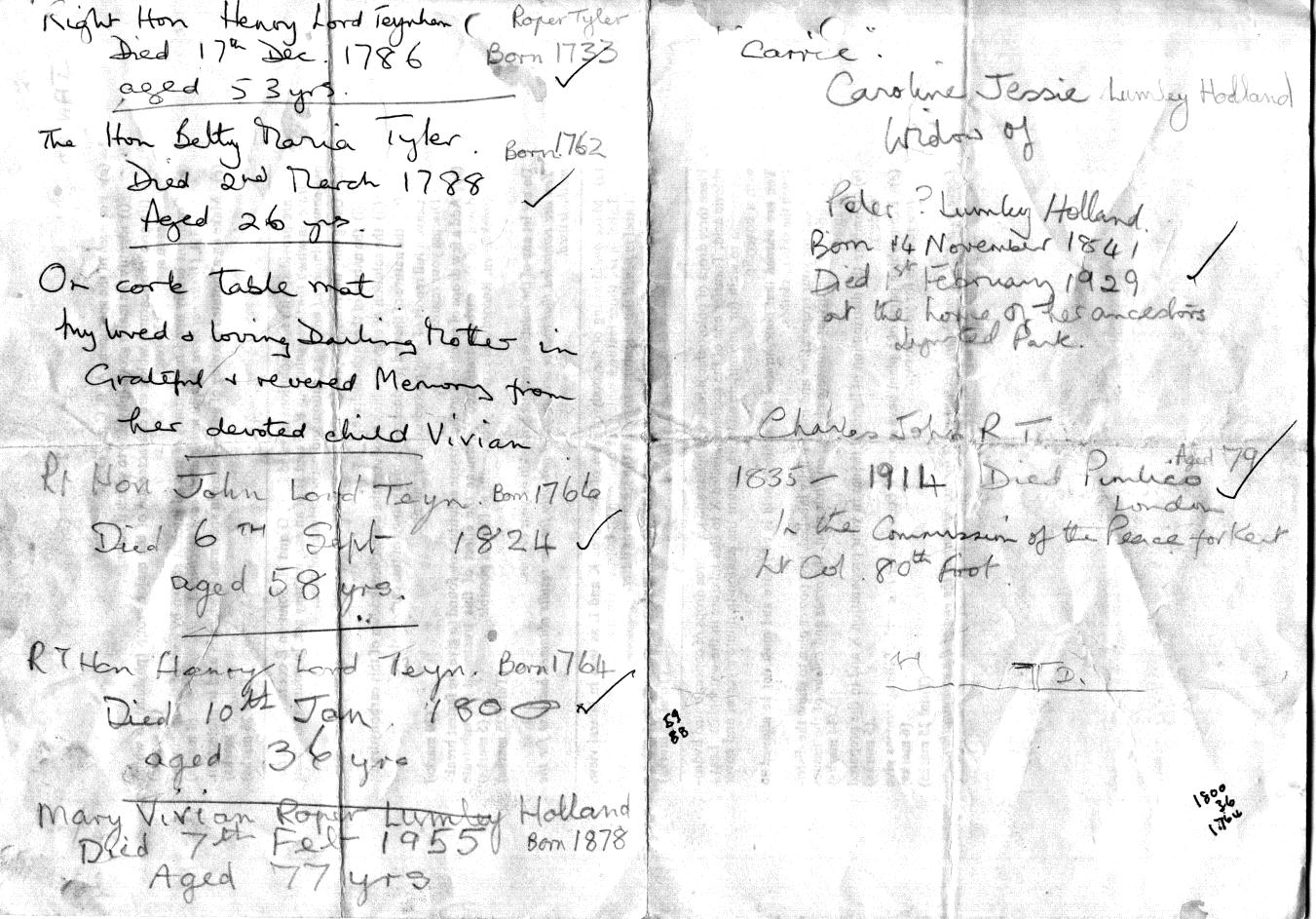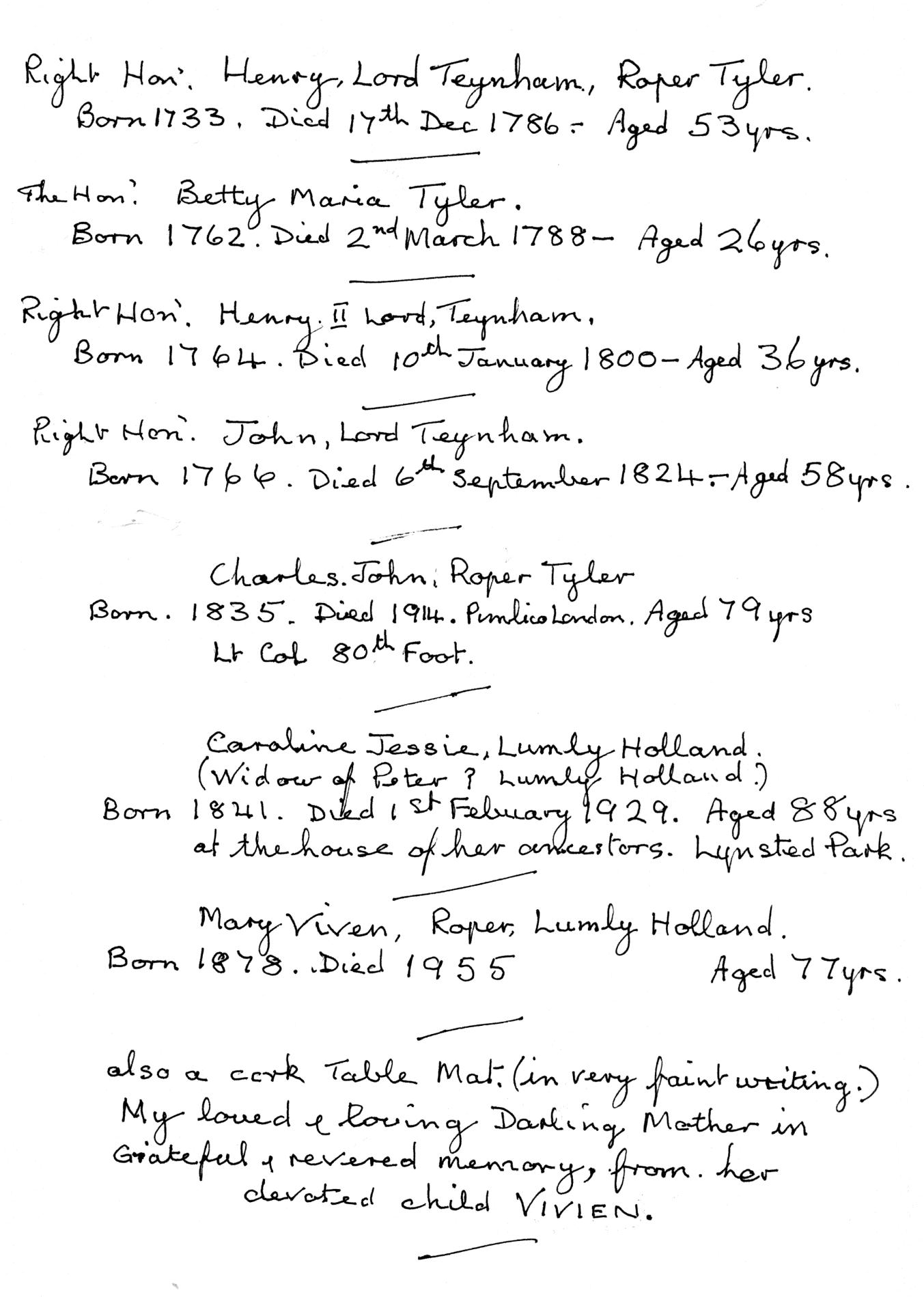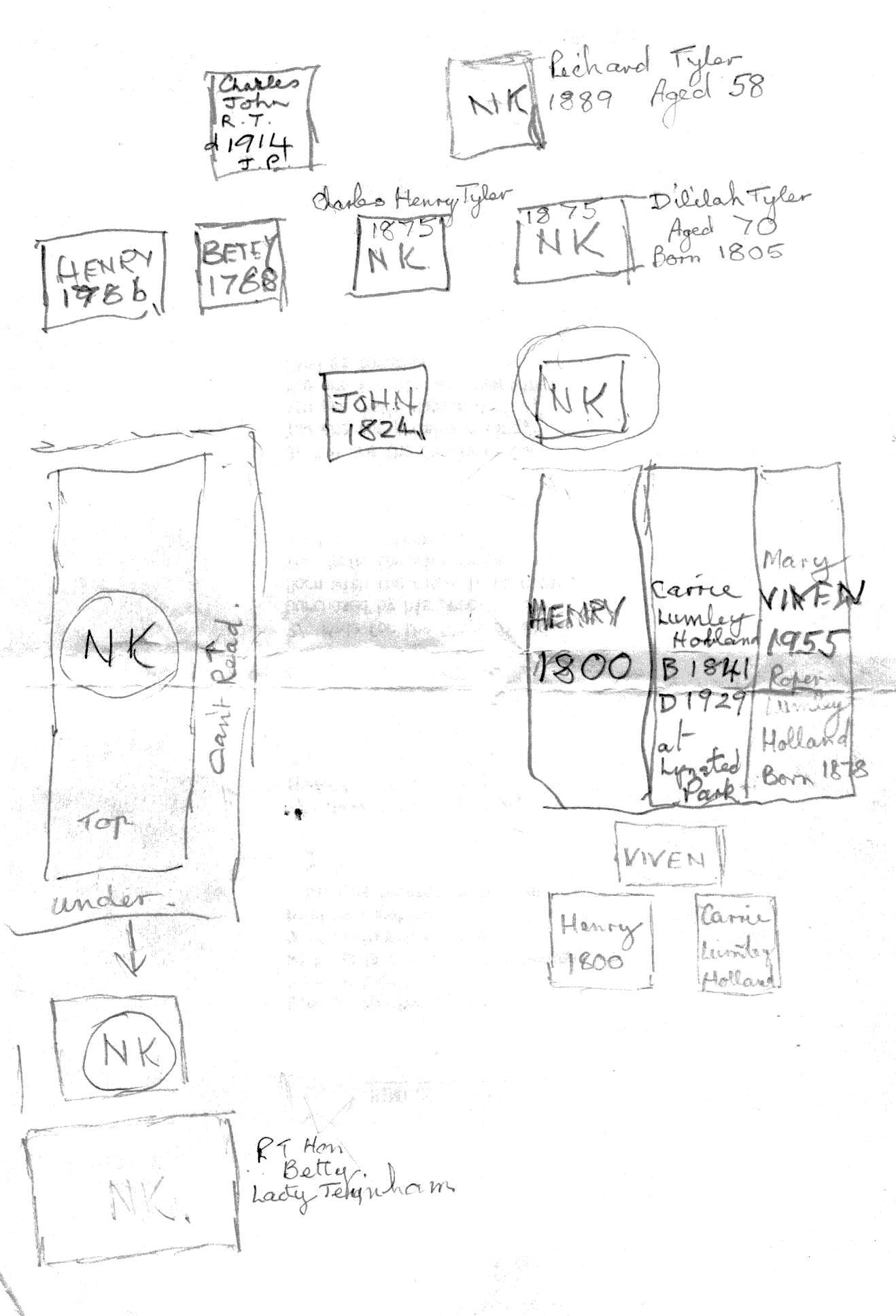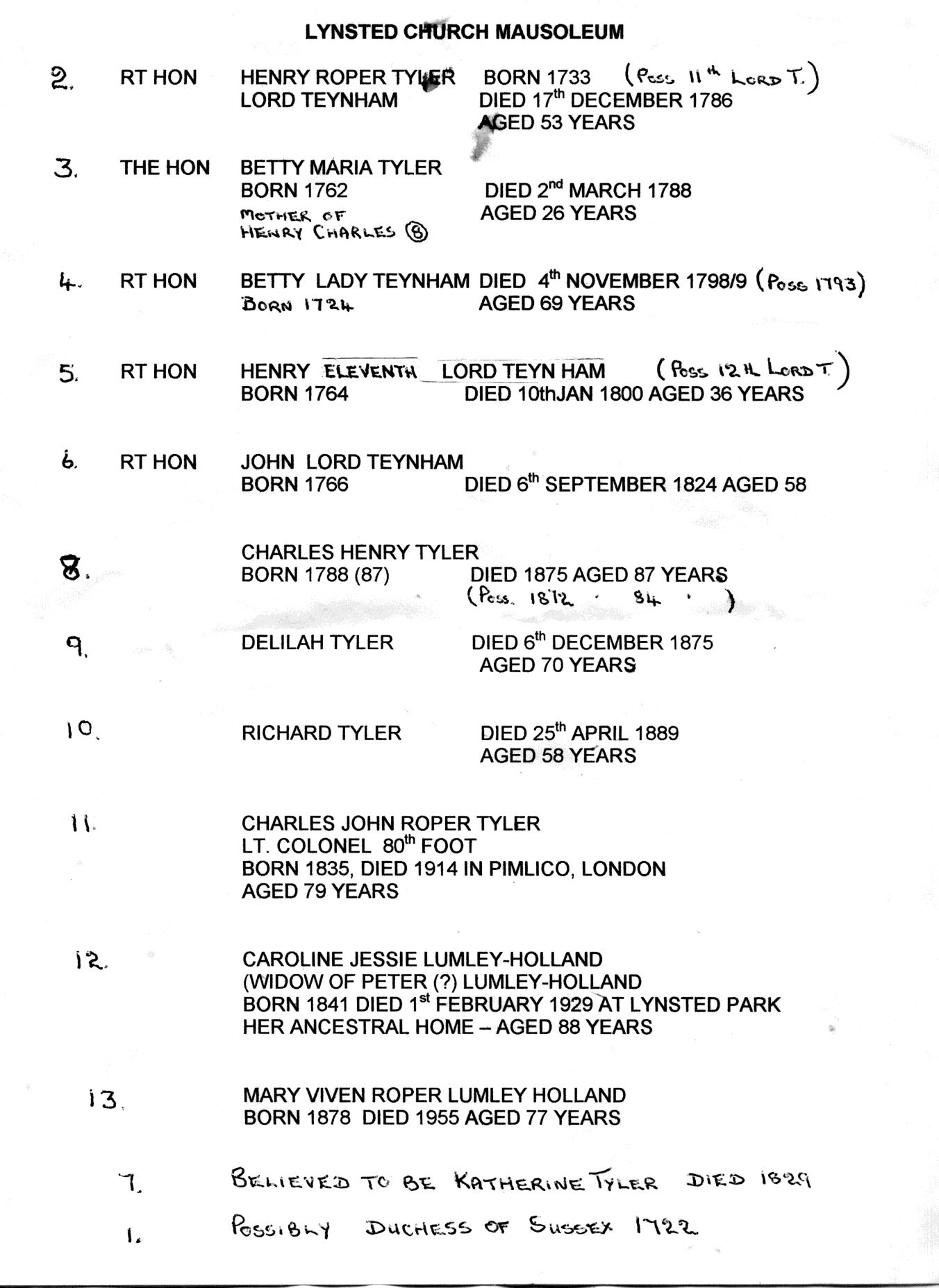The Roper Mausoleum - Church of Saint Peter and Saint Paul
Research notes: developed by Ken Diamond and Trevor Jewsbury
to whom we are grateful for sharing with the Society.
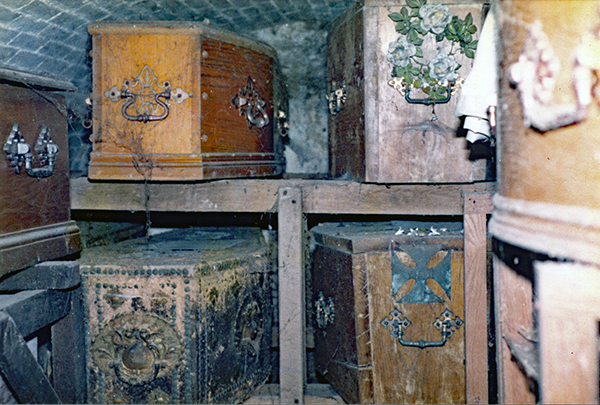
KEY TO SURVEY OF PLAQUES
11. Charles John Roper Tyler 1835 - 1914 |
10. Richard Tyler Died 1889 Aged 58 Yrs |
||||||||||
2. Henry Roper-Tyler Lord Teynham 1733-1786 |
3. Betty Maria Tyler 1762 - 1788 Aged 26 Yrs |
8. Charles Henry Tyler 1788 - 1875 |
9. Delilah Tyler Died 1875 Aged 70 Yrs |
||||||||
6. John Lord Teynham 1766 - 1824 |
7. The Honorable Catherine Tyler Died 1st May 1829 Aged 66 Yrs |
||||||||||
| 1. (no plaque found) |
13. Mary Viven Roper-Lumley Holland 1878 - 1955 |
||||||||||
4. Betty The Rt. Hon Lady Teynham Died 1798 Aged 69 Yrs |
12. Caroline Jessie Lumley Holland 1841 - 1929 |
||||||||||
5. Henry Lord Teynham 1764 - 1800 |
|||||||||||
| (Where Visible With Careful Use Of Mirrors And Torches) | |
| 1. POSSIBLY DUCHESS OF SUSSEX 1722 | |
| 2. RT HON HENRY TOPER TYLER/LORD TEYNHAM | |
| Born 1733 Died 17th December 1786 Aged 53 Years - - MS Note: "possibly 11th Lord Teynham" |
|
| 3. THE HON BETTY MARIA TYLER | |
| Born 1762 Died 2nd March 1788 Aged 26 Years - - MS Note: "Mother of Henry Charles (B) her only son – 1788; Married Francis Henry T." |
|
| 4. BETTY/THE RT HON LADY TEYNHAM | |
| Born 1724 Died 4th November 1798/9 ("possibly 1793") Aged 69 Years |
|
| 5. RT HON HENRY/SECOND LORD TEYNHAM ("11th Possibly 12th Lord T") | |
| Born 1764 Died 10th January 1800 Aged 36 Years |
|
| 6. RT HON JOHN/LORD TEYNHAM ("13th") | |
| Born 1766 Died 6th September 1824 Aged 58 |
|
| 7. BELIEVED TO KATHERINE TYLER | |
| Died 1829 | |
| 8. CHARLES HENRY TYLER | |
| Born 1788 (87) ("February") Died 1875 Aged 87 Years - - MS Note "Possibly Died 1872 Aged 84 Years" |
|
| 9. DELILAH TYLER | |
| "Born 1805" Died 6th December 1875 Aged 70 Years |
|
| 10. RICHARD TYLER | |
| "Born 1831" Died 25th April 1889 Aged 58 Years |
|
| 11. CHARLES JOHN ROPER TYLER | |
| Born 1835 Died 1914 in Pimlico, London Aged 79 Years - - MS Note "Lt. Colonel 80th Foot" |
|
| 12. CAROLINE JESSIE LUMLEY-HOLLAND | |
| Born 1841 Died 1st February 1929 ("at Lynsted Park her ancestral home") Aged 88 Years |
|
| 13. MARY VIVEN ROPER LUMLEY HOLLAND | |
| Born 1878 Died 1955 Aged 77 Years |
|
MANUSCRIPT SPEAKING NOTE FOR 'OPEN DAYS'
The Lynsted Church mausoleum attracts a surprising amount of interest but not of the morbid kind. Most visitors are fascinated by the status of those interned therein together the history of the times through which they each lived.
There is also a keen interest in the quality and finish of the actual coffins and why the differences arose.
As many of you are aware it has been a practise for the mausoleum to be opened for interested viewers during social or open days at the church to which end some research has been carried out over the years by a few volunteers.
There are thirteen incumbents in the mausoleum and until a couple of years ago only about half of them had been identified for certain. The Parish records are not always clear as to where such deceased were actually placed. Examination of the pedigree of the Roper and Roper-Tyler family pieced together much of the jig-saw but did not tell us exactly who was placed where. The answer was to read the brass name plate affixed to each coffin (almost) but this proved easier said than done.
Before proceeding it is interesting to know something about the occupants. The first internment was possibly that of Henry Roper-Tyler – Lord Teynham who died in 1786 and the last was Mary Vivien Roper-Lumley Holland who was placed there in 1955.
They are believed to be all members of the Roper-Tyler family who were the local gentry over many years and it is likely that the mausoleum came into use once the church crypt became full.
The quest to identify the different coffins took not a little time and some ingenuity. Obviously the place needed to be treated with the greatest respect and least disturbance. The coffins are stacked fairly close together making it difficult to access the name plates in order to read them. The solution was to use mirrors and torches, generally specially rigged to provide visual contact. The brass plates were then painstakingly read a letter at a time – a difficult task when reading them when reflected and therefore back to front. However some good progress was made and eventually only two coffins remained. One carries no identification that is apparent, the other offered a space of some two or three inches of space between the lid and the coffin above. This was too small to be able to use mirrors and the only solution appeared to try brass rubbing the nameplate using paper and wax specially set up on thin battens. The process was not successful but it was noticed that the plate was loose on the lid, so a dedicated flat spade was made and the nameplate was carefully lifted off, read and replaced. It said –
The honourable
Catherine Tyler
DIED 1st May
1829
AGED 66 YEARS
There remains but one coffin which is far from ancient, unmarked and close to the door. From a slight warping of the lid it reveals a lead lining and it is possibly a replacement to one much older. There is written evidence that the Duchess of Sussex who was the illegitimate daughter of Charles II is interned in the mausoleum. She died in 1722 and would therefore be the earliest occupant but as there is no hard evidence to this so the mystery remains – but then that in itself is interesting.
Note: Details of the unnamed Coffin (Author not known)
One of the mistresses of King Charles was Lady Castlemain. He had a daughter by her who was called Ann. This young lady seems to have been something of a problem. She spent some of her time in France associated with the Duchess of Mazerin.
Later she returned to England and married Lord Dacre who later became Earl of Sussex. The marriage was an unhappy one and the couple soon parted.
When the Earl died in 1715 Ann married Henry the 8th Lord of Teynham and came to live in Lynsted in the house known as Lynsted Lodge (now Park) which she enlarged to 100 rooms.
After the death of her husband she moved to the house we now know as Dadmans. It was her she died in 1722 and her body was interned in the Roper Mausoleum.
The entry in the Parish Register simply reads: "the Right Honourable Ann, countess of Sussex, Dowager". Please excuse the bad typing.
ADDITIONAL NOTES ON THE PERIOD - MADE BY THE RESEARCH GROUP
- Bonny Prince Charlie – Culloden;
Bach Died 1750 New style calendar 1752 (Age?);
American Independence 1777/83
- Similar
- French Revolution and Rise of Bonaparte
- Bonaparte on rampage through Europe
- Waterloo;
Deaths of George III and Napoleon;
Singapore founded
- Spread of Empire;
Victoria as Queen
- Victoria as Queen
- South Africa;
Suez Canal
- Victoria Dies;
Boer War;
1914-1918 World War I
- Lindbergh flied Atlantic;
Russian Revolution;
Titanic
- World War II (1939-45)
- Charles 1st Executed 1649
- Charles 2nd 1660 – 1685
The Roper Chapel
The Roper family has been connected with Kent since the 13th century. In 1377, John Roper lent £40 to help furnish a fleet against the French. Another John Roper of Swalecliffe acquired Well Hall, Eltham by marriage and his son married Margaret, the daughter of St Thomas More, Lord Chancellor of England under Henry VIII. More was executed in July 1535. His daughter bribed the executioner to drop his head on to a barge and it was taken to a house called Bumpit in Lynsted, near Lynsted Park. Finally it was transported to St Dunstan's in Canterbury. The chapel contains two tombs. On the south side lies John Roper, later Sir John, who became Lord Teynham by being the first in the country to recognise James I as king. His wife and children are buried under the chapel floor. Christopher, second Lord Teynham, is portrayed in his armour, gazing towards the altar. His widow, in contemporary French mourning dress, kneels beside him. Beneath are two panels by Evesham, a very important religious artist of his day, who was born in Hertford in 1570. The right panel shows Teynham's two sons, just back from hunting, with hawks and dogs in the background. The left panel shows his five daughters, four of whom became nuns (the married one is wearing a hat). The kneeling daughter became the abbess of the Benedictine Abbey of Ghent; she comforted Charles II after the execution of Charles l in 1649. The chapel is a telling example of England's religious divisions. From the late 16 century onwards Catholics were not admitted to the main body of the church, but used the little outside door to attend services. In the 19th century, the wooden screen was added to separate Catholics from Protestants. This screen has now been opened, as a sign of reconciliation and hope that all Christians may now pray together in unity and without division.
Miscellaneous manuscript Notes (unattributed)
LYNSTED. All of flint. The E & west walls have C12 work. Grayling says that the first enlargement was on the north, C1307: we are not sure why he is so positive about the date. This would be the north-west tower & N aisle, of which there are signs on the east of the tower. The present aisles of arcades are well on in the 14th cent. Chapels were also added the north was rebuilt in late Perp. Chancel roof 14th ent., nave roof 15th. ICBS grants 1828 – 1933 – but Christian also rest? The Chancel and as we have particulars we may as well set them down this report is dated May 27, 1854 his estimate was £69. The work was done by W C Vallance of Green Street, Sittingbourne, & his certificate for payment (£80) is dated August 27, 1855. In Dec. the Vicar wanted a new altar rail. Christian was to design it. June 15, 1857, Lady Knatchbull desired to erect a carved stone screen to her chapel & a carved oak one, & would erect stalls in the chancel. R C Hussey made the designed in 1884 part of the belfry was blown down & repaired at a cost of £52. 4. 6. 1895, application to the Commissioners for help towards restoring the church they gave £20. The architect was R P Day, diocesan surveyor. The work went on until 1905.
It is quite a pleasant, spacious interior but we have to complain once again of recent glass. The E. window & the N. chapel window are wrecked & do their best to spoil the effect Branch in the nave 1686.
The monuments are the chief feature. In N. chapel (in chronological order). Catherine wife of Sir Drue Drurye 1601. The usual kneeling figures – a bit better than usual he (though not mentioned except as her husband), one son & three daughters. John Hugessen 1634, & LED KNEELING FIGURES Josias H 1639 (tablet) James H 1645, Jane and family: rather poor in poor condition.
Manuscript Notes made during project (Ken Diamond)
